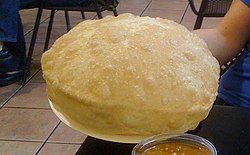Bhatura
Thank you for being part of the Bharatpedia family! 0% transparency: ₹0 raised out of ₹100,000 (0 supporter) |
 | |
| Place of origin | Punjab |
|---|---|
| Region or state | Northern regions of the Indian subcontinent |
| Associated national cuisine | India, Bangladesh, Pakistan |
| Main ingredients | Maida, dahi (yogurt), ghee or oil, yeast |
| Variations | Puri, Luchi |
Bhatoora (also known as batoora, bhatura, batura, or pathora) (Hindi: भटूरा, Punjabi: ਭਟੂਰਾ) is a fluffy deep-fried leavened sourdough bread originating from the Indian subcontinent.[1] It is commonly served as a midday meal or a breakast dish in northern and India.[1] Paired with chickpea curry, called chhole or channe, it forms a traditional dish called chhole bhature which originated in Punjab.
This bread is like the puri bread but is made with leavened dough.[2]
Preparation[edit]
A typical recipe includes all-purpose flour (maida), dahi (yogurt), ghee or oil, and either yeast or baking powder. Once kneaded well, the dough is left to rise, and then small balls of this dough are either hand-rolled or flattened using a rolling pin. The bread pieces are then deep fried until they puff up into a lightly browned, soft, fluffy bread, which is elastic and chewy.[3]
Bhatura is often eaten with yogurt, pickle, or vegetables. When eaten with chole, it forms a popular traditional dish known as chole bhature.[1][4]
Variations[edit]
A variation of this dish is to use semolina flour instead of all purpose flour. [5] Other variations include aloo bhatura (bhatura filled with potato) and paneer bhatura (bhatura filled with paneer).
A nonfried variant is the kulcha, which can be baked or cooked on a flat pan and is garnished with coriander leaves.
See also[edit]
- Chana masala
- Punjabi cuisine
- Puri
- Paratha
- Roti
- Naan
- Kulcha
- List of Indian breads
- List of Pakistani breads
- Fried bake, a very similar fried bread found in Trinidad, in the Caribbean
References[edit]
- ↑ 1.0 1.1 1.2 Bhanwar, Seema; Bamnia, Meenakshi; Ghosh, Moushumi; Ganguli, Abhijit (2012). "Use of Lactococcus lactis to enrich sourdough bread with g-aminobutyric acid". International Journal of Food Sciences and Nutrition: 1–5.
- ↑ Ramineni, Shubhra (28 February 2012). Entice With Spice: Easy Indian Recipes for Busy People. ISBN 9781462905270.
- ↑ Gadia, Madhu (2009). The Indian Vegan Kitchen. Penguin Publishing Group. p. 300.
- ↑ Patel, Varsha (2013). Recipes from My Home Kitchen. Xlibris Corporation. p. 28.
- ↑ Godbole, Nandita (2014). A Dozen Ways to Celebrate: Twelve Decadent Feasts for the Culinary Indulgent. Curry Cravings.
External links[edit]
- Bhatura recipe Archived 5 July 2017 at the Wayback Machine
- Bhatura recipe
- http://www.tarladalal.com/Chole-Bhature-2810r




